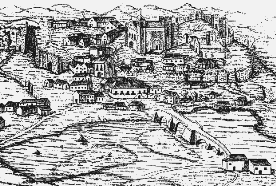|
Silves |
|
| Portugal > Tourism > Algarve > Silves > History | |
| Municipality | Places of Interest | Silves Town | Lodging | |
|
The presence of man during the Palaeolithic period is confirmed
by one archaeological site. The whole of the area of what is now
Silves municipality was however inhabited during the Neolithic period
and the Bronze and Iron Ages, a fact born out by numerous archaeological
finds. Particularly impressive are the abundant megalithic monuments
menhirs - carved out of the region's red sandstone and of limestone. |
|
 |
|
By the 11th century it was the capital of the Algarve and according
to some authors surpassed Lisbon in size and importance. At this time
Silves was also a centre of culture, home to poets, chroniclers and
lawmakers. The religious arid political tremors that rocked the Moslem
world in the 11th and 12th centuries were felt in Silves too, where
they manifested themselves in frequent changes of ruler and sieges
and struggles that pitted rival factions against each other. King
Sancho I took advantage of this internal division to lay siege to
the city in 1189. His army was aided by crusaders from Northern Europe
who were on their way to the Holy Land. |
|
Natural catastrophes like the plague, earthquakes caused by the swamp that formed where the Arade had once flowed also contributed to the town's decline. The coup de grace came in 1534, with a papal bull allowing the transfer of the Episcopal see to Faro, a possibility that only became a reality years later. Silves was never to recover its past splendour and for almost three centuries it was a city inhabited by only a few remaining citizens. But in the second half of the 19th century dried fruit and, above all, cork breathed new life into the city, which became one of the main processing centres for those products. Today Silves is a town proud of its past, at the heart of a municipality with a thriving economy. |
|
 |
| Municipality | Places of Interest | Silves Town | Lodging | |
| Portugal > Tourism > Algarve > Silves > History | |
|
History |
|